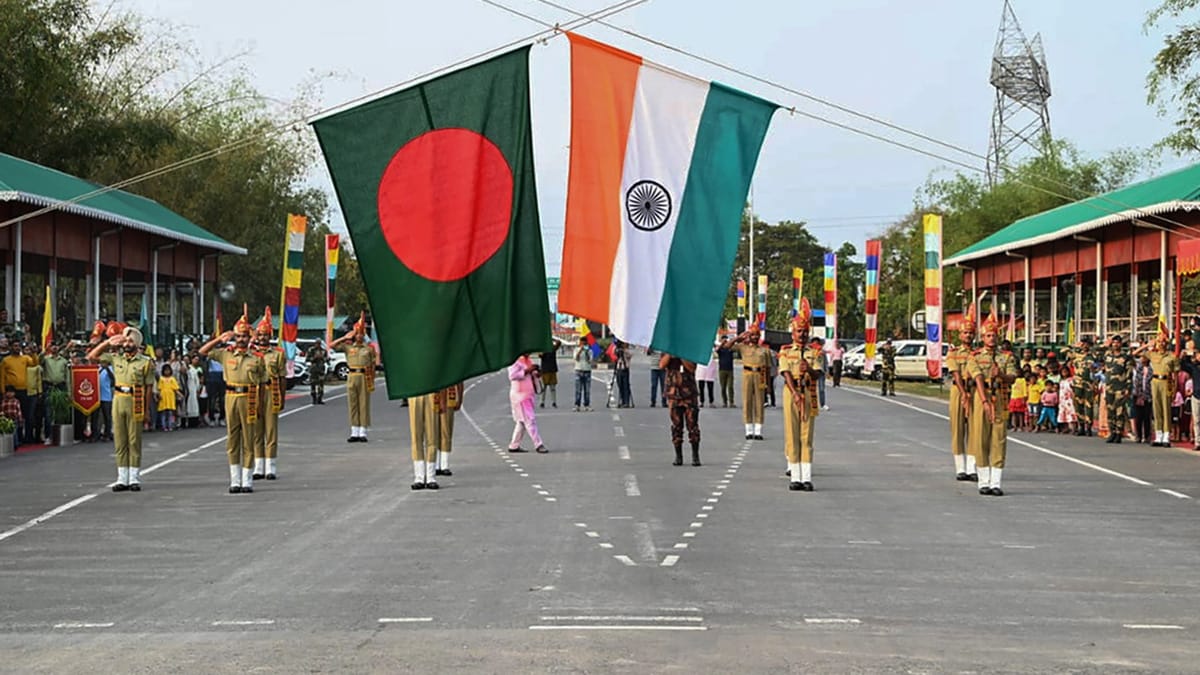
The Bangladesh political impasse does not show any sign of recovery any time soon, though much hope has been pinned on Muhammad Yunus, a Nobel Laureate in Economics. Inarguably, it is quite early to assess an interim government. The passion and promise for a dramatic difference with Professor Yunus at the helm of politics fit the propaganda of the protesters.
The ground reality is full of paradoxes. The shameful August political episode led to the country’s complete collapse. Anarchists quickly hijacked the protest by the angry and agitated students on the reservation issue.

Loot, arson, vandalism, vulgarity, and planned attacks on the Hindus and other minorities became the new normal. Muhammad Yunus’ quick jump into politics to restore normalcy shows no visible difference. The evident forms of violence have become more subtle.
The antagonism against the Hindus and India has not seen any changes. The platitudes of Yunus are for media exhibitionism for perception building. It gives no dividend in any significant sense.
Amid the whirlpool of things, what undergirds the political collapse is the foreign interventions. The obvious ones are the US and China. Sheikh Hasina has already made a reference to the US intervention and the latter’s interest in St Martin Island.
China has seemingly escaped the critical lens. She has not critically mentioned China or its role in the Bangladesh crisis. The US-China rivalry and competition in the Indo-Pacific are out in the open.
This has reached the Bay of Bengal. The waters of the Bay of Bengal have become geopolitically and geostrategically hotter. The political breakdown and the rise of radicals to destabilise the country is a surface convulsion in Bangladesh.
The latent points to the collision of interests involving the US and China. The Indian control over the waters of the Bay of Bengal is quite deep and carries a strong history. The US intends to ensure its stable presence in the region to control China and its expansionist streak.
Bangladesh’s indifference to the US’ strategic blueprints for the Bay of Bengal saw the unleashing of the former’s covert and soft methodologies of destabilising a country. The strategic Mongla and Chittagong ports have seen significant Indian presence for export and import-related activities. The current political tension has not seen any significant change in the nature of the MoU between India and Bangladesh.
However, the symptoms are not clear enough to diagnose the shifting moods of Bangladesh under Muhammad Yunus and his external accomplices. The US is expected to make significant entry into the waters of Bangladesh through Muhammad Yunus. This will minimise Chinese brinkmanship in the region.
But the chequered history that India shares with the US and the latter’s unpredictability and the persistence of its alliance with Pakistan constitute a compelling ground for doubt and apprehension. India’s relationship with the US has not seen its best. India exercises much caution while steadying its relationship with the US.
Its partnership with Russia and its political philosophy of non-alignment in times of conflict have neither bagged any distinction for India historically nor secured appreciation from the US. While discussing the US interventions in the Bangladesh conflict, China’s role cannot be ignored. China is strategically expanding its sphere of influence in the Bay of Bengal.
India, the old Bay of Bengal maritime player, finds a competitor. China is not a littoral state in the Bay of Bengal. It attracts countries to its sphere of influence through the Belt and Road Initiative (BRI) and gradually interferes with their sovereignty.
The interference becomes more defined in the country concerned that fails to complete the installment repayment of the loan taken. Sri Lanka and Pakistan are unambiguous instances of debt-trap diplomacy. Through Pakistan, China reaches the Arabian Sea.
The China-Pakistan Economic Corridor (CPEC) enables this connectivity. For the Bay of Bengal, most littoral states have fallen mainly into its BRI expansionist trap. The littoral countries of the Bay of Bengal are India, Bangladesh, Sri Lanka, Myanmar, Thailand, Malaysia, and Indonesia.
India’s non-participation in the Belt and Road Initiative Leviathan and its growing confidence and geostrategic advantage to give China a checkmate in the Himalayan space and the Indian Ocean have intensified the latter’s resolve to restrict the former’s sphere of activity. Therefore, it makes necessary preparations to exercise its presence in the Bay of Bengal through its littoral states. Bangladesh, Sri Lanka, Myanmar, Thailand, Malaysia, and Indonesia are part of China’s BRI framework.
China exercises its control over the Bay of Bengal littoral states. Beyond its BRI commitments, it interferes with the critical strategic space of these countries, seriously compromising their territorial integrity and sovereign strength. The objective is to give India challenges if any conflict emerges in the region.
The Chinese maritime reconnaissance and electronic intelligence station on Great Coco Island and the facilities on Ramree, Haigyi, and Zadetkyi Kyun Islands in Myanmar indicate its ulterior motive. The strategic ports, namely the Chittagong port in Bangladesh, where China has invested, suggest its depth in the Indian neighbourhood. Despite India’s long diplomatic relations with Bangladesh and its legal access to the Chittagong port, China has intervened in the port under the pretext of investment.
Under Chinese control, the Hambantota port in Sri Lanka intensifies surveillance of Indian marine and defence activities. The Indian peninsula is loaded with Indian critical defence and strategic installations. Hambantota port has reportedly become the Chinese maritime observatory for mapping Indian strategic preparedness.
The 99 years of the contract indicate Beijing’s long and comprehensive plan to encircle India and force the latter to become more defensive. These acts of interference will intensify the geopolitical rivalries between them. BRI and its economic and developmental models offer China leeway in developing strategic assets.
China’s double-dealing in the name of BRI engenders risk perception. Myanmar’s SEZs in Kyauk Phyu, Thilawa, and Dawei and seaport facilities are reported to have Chinese Navy access. China has invested in the Industrial Development Zone in Chittagong and the Payra Deep Sea Port in Bangladesh.
It holds a 70 per cent share of the 750-acre industrial park in Chittagong in exchange for an investment of $10 billion. It has also shown its interest in investing in the Sonadia Deep-Sea Port Project. It has built a single-point mooring system at the Chittagong Port for its first sea-land integral super-large oil storage.
The Kyaukphyu Port’s proximity to the key Indian naval base, INS Varsha, raises security concerns. The Chinese presence in the port is a security challenge. This naval base houses India’s nuclear attack and ballistic missile submarines and is crucial from a critical strategic perspective.
China’s investment in the Mongla seaport in Bangladesh with a government-concessional loan of US$400 million under the ‘Expansion and Development of Mongla Port Facilities’ and the building of two container jetties indicates its interest in the Bay of Bengal. Beijing intends to convert Mongla Port into an alternative maritime transport route to decouple its dependencies on the Malacca Straits. The Chinese company Yun Sheng BD will likely develop a composite industry in the Mongla Export Processing Zone.
The industry will combine textiles, garments, and accessories to ensure employability for the Bangladeshi youth. However, the fear of being trapped in debt and losing agency, autonomy, and sovereignty is unavoidable. The China-built Bangladesh’s BNS Sheikh Hasina submarine base off the coast of Cox’s Bazaar in the Chittagong Division is likely to position Chinese submarines close to India’s Andaman and Nicobar Command.
The motives of the so-called Chinese research vessel in the Indian Ocean region are to exercise espionage on Indian critical infrastructures, especially in the testing of the 5,000-km-range Agni-5 intercontinental ballistic missile. Beijing might deny these allegations, but the research vessel’s espionage aspects cannot be refuted. It is also reported that China’s upcoming port is going to be built near Abdul Kalam Island, DRDO’s missile testing centre, and extremely critical infrastructure, which might play a critical role in the event of a nuclear exchange.
These developments complicate the emerging dynamics of power rivalry in the Bay of Bengal. Against this background, India and Japan are making necessary efforts in the littoral states of the Bay of Bengal to decouple them from China’s sphere of influence and debt trap through BRI. India has extended 37 Lines of Credit (14.
2 billion USD) to Bangladesh, the Maldives, Myanmar, Nepal, and Sri Lanka for 162 infrastructure development and connectivity projects under its Neighbourhood First Policy (NFP). Under the flagship of NFP, Bangladesh has taken $7.362 billion in concessional credit from India.
Around 350 Indian companies are working in Bangladesh. The prominent ones are Adani Power, Hero MotoCorp, Tata Motors, Asian Paints, Dabur, Emami, VIP, Marico, Pidilite, Reliance Power, etc. They strengthen the economy of Bangladesh.
India is Bangladesh’s biggest trade partner in South Asia and largest export partner in Asia. India’s export to Bangladesh in the financial year 2022 was $16.15.
It was $12.20 in 2023. Dhaka depends on New Delhi significantly.
Exacerbating this relationship will harm Dhaka badly. Hopefully, the ongoing crisis will not intensify because it will not be good news for Bangladesh, especially its fragile economy. From the Indian geostrategic point of view, Mongla Port is crucial because it is a key to consistent connectivity with India’s landlocked northeast.
New Delhi is building the Khulna-Mongla Port Rail Line to diversify its dependencies instead of crystallising its focus on Chittagong Port. The Akhaura-Agartala Cross-Border Rail Link and Unit II of the Maitree Super Thermal Power Plant are the other projects of critical importance. The rail linkages with Bangladesh include Haldibari (India)-Chilahati (Bangladesh), Petrapole (India)-Benapole (Bangladesh), Gede (India)-Darshana (Bangladesh), Singhabad (India)-Rohanpur (Bangladesh), and Radhikapur (India)-Birol (Bangladesh).
Maitri Express connecting Kolkata and Dhaka (since 2008), Bandhan Express between Kolkata and Khulna (2017), and Mitali Express between New Jalpaiguri and Dhaka (2022) connect the two countries by train. India has invested significantly in Bangladesh to develop inland waterways (Sonamura and Daudkandi), energy security (India-Bangladesh Friendship Pipeline), and community development projects (skill development and training institutes, cultural centres, hostels, orphanages, academic buildings, student exchange programmes, hospitals, etc.).
Japan has also invested significantly in Bangladesh, Myanmar, and Sri Lanka to present a more feasible and dependable alternative than the hegemonic China, which uses the countries under BRI for its expansionist streak. The Malabar exercise—joint maritime exercises involving India, the US, and Japan in the Indian Ocean region—indicates the gravity of the Chinese threat. India is intensely extending its efforts to build better relationships with its Bay of Bengal neighbourhood.
However, the Chinese BRI and its economic might swing littoral countries to the dragons. China uses these countries for its expansionism and control. Its increasing depth in the Bay of Bengal risks India’s security space.
India has to reconnect with its neighbourhood and strengthen its security apparatus. It must reconceptualise its neighbourhood policy. The current crisis in Bangladesh demands robust strategic preparedness from India to preempt the possible conflicts and protect its maritime interest in the Bay of Bengal.
China and the US push their way into the Bay of Bengal. Chinese Foreign Direct Investment (FDI) in Bangladesh has become larger than the US. Apart from FDI, its BRI has invested massively in the port, transport, industrial, energy, and communication infrastructures.
Its strategic ‘String of Pearl’ maritime idea to encircle India is underway. Therefore, India has to act smartly to protect its interest in the Bay of Bengal, which has already become the geopolitical and geostrategic hub of a bigger conflict between China and the US. The Bangladesh crisis is just a symptom.
Jajati K Pattnaik is an Associate Professor at the Centre for West Asian Studies, School of International Studies, Jawaharlal Nehru University, New Delhi. Chandan K Panda is an Assistant Professor at Rajiv Gandhi University (A Central University), Itanagar. The views expressed in the above piece are personal and solely those of the authors.
They do not necessarily reflect Firstpost’s views..














